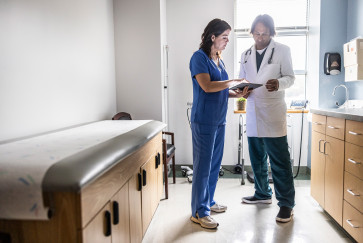As new cases of the novel coronavirus known as COVID-19 were reported in China and beyond, concerns about possible transmission of coronavirus from pregnant women to their unborn children also arose, after Chinese state media reported on an infected patient who gave birth to a baby who later tested positive for the virus.
A new study published in The Lancet, however, has found no evidence that COVID-19 is passed from women in their third trimester to their unborn fetus in the womb, a mechanism known as vertical transmission, based on examination of medical records and tissue samples from nine pregnant patients who were infected with the disease.
If proper isolation practices during and after birth are followed, women diagnosed with COVID-19 should be able to deliver healthy babies without the infection, said Wei Zhang, associate professor of preventive medicine at Northwestern University Feinberg School of Medicine and co-author of the study. Wei cautioned, however, that these results may not be generalizable to earlier-stage pregnancies.
“Many pregnant women are concerned right now, and these findings confirm there’s no scientific evidence for vertical transmission,” Zhang said. “But, all of the women in this study were in the later stages of pregnancy: we don’t yet know about any potential transmission during earlier trimesters.”
Investigators at Wuhan University studied nine pregnant women who were diagnosed with COVID-19 during the third trimester of their pregnancies. The scientists analyzed samples of amniotic fluid and umbilical cord blood taken before birth, then tested the infants after they were delivered via caesarean section, finding no evidence of COVID-19 in any fluids.
"It is important to note that many important clinical details of this case are missing, and for this reason, we cannot conclude from this one case whether intrauterine infection is possible,” said lead study author Yuanzhen Zhang, chief physician and professor at Zhongnan Hospital of Wuhan University in China, in a press release. “Nonetheless, we should continue to pay special attention to newborns born to mothers with COVID-19 pneumonia to help prevent infections in this group.”
A caesarean section and isolation — separating the infant from the mother — are crucial to ensuring the infant does not contract COVID-19 during or after birth, according to Zhang.
“The baby is at a high risk of infection after birth, so everything should proceed carefully: The baby should be removed from the infected mother immediately and be put under close monitoring,” Zhang said.
In addition, while it’s a small sample, women in this study did not experience pregnancy complications similar to those often experienced in pregnant women with another, similar disease, severe acute respiratory syndrome coronavirus (SARS-CoV).
While both infectious diseases are coronaviruses first discovered in China, COVID-19 continues to show significant differences from SARS-CoV0-2. Notably, COVID-19 appears to be much more infectious, and according to Zhang, the number of infected people could be more than 100,000 — meaning the number of pregnant women with the infection also could be much higher.
“That’s why it’s important to provide this clinical evidence,” Zhang said. “We found that with preparation and isolation, these women should be able to birth a healthy baby, and that’s important for families all over the world.”
Before the COVID-19 outbreak, Zhang was working with investigators at Wuhan University to discover genetic biomarkers for early detection of ovarian cancer and diabetic complications. After the outbreak, the Wuhan team shifted their focus to COVID-19, and Zhang, working from Chicago, provided epidemiology and data interpretation on the study.
This study was supported by Hubei Science and Technology Plan grant 2017ACB640 and Wuhan University Medical Development Plan grant TFJC2018001.


